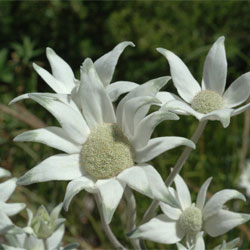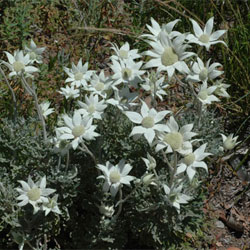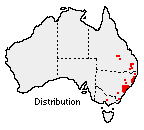Actinotus helianthi
 |
 |
Flannel Flower
Actinotus helianthi is commonly called Flannel Flower due to the soft woolly feel of the plant. A selection of Actinotus helianthi is sold under the named cultivar 'Federation Star', as it is the chosen New South Wales floral emblem for the Centenary of Federation (1901-2001).
 The
genus Actinotus contains 20 different species, 19 of which are endemic
to Australia, extending with one species to New Zealand. Actinotus helianthi is endemic to Australia and has a natural range extending from central and south-eastern
Queensland down to the south coast and western slopes of New South Wales.
The
genus Actinotus contains 20 different species, 19 of which are endemic
to Australia, extending with one species to New Zealand. Actinotus helianthi is endemic to Australia and has a natural range extending from central and south-eastern
Queensland down to the south coast and western slopes of New South Wales.
Actinotus helianthi enjoys temperate conditions and can prosper in a wide range of environments including coastal heath, scrub, and dry sclerophyll forest, shallow sandy soil and exposed situations. Actinotus helianthi is tolerant to mild frost once established but for the plant to prosper it requires a well-drained moderately acid (pH5-6) soil, as it will not tolerate "wet feet". The plant grows in full sun or part shade but and may need protection from wind due to the shallow root system.
The size of the plant depends largely on environmental conditions, but it can vary in height between 0.5 m and 1.5 m. The nature of the plant also varies between a large herbaceous plant and a small shrub.
The entire plant has a soft woolly feel due to the presence of soft white hairs. The leaves are biternately divided and alternately arranged and are an attractive grey-green colour. The inflorescences of the plant has a simply 'daisy like' shape that is highly characteristic and ranges in size from 2.5-8 cm. The flowers are arranged in umbels that range in size between 12-20 mm diameter. The umbels are surrounded by bracts that are very soft to the touch and are characteristic with their white and green tipped colour.
Actinotus helianthi has a gradual flowering throughout the year with a peak during September- November. Pruning after flowering will increase the bushy habit of the plant and increase the number of flowers produced in the following year. Shaping can also be achieved by pruning and as such Actinotus helianthi makes an excellent potted plant or decorative shrub.
Propagation is best by fresh seed, and the plant is able to quite successfully self-seed. Firm cuttings have also been successful for propagation. Plant health can be maintained by planting the plant in the final position, as transplantation can be highly stressful. The addition of mulch also helps to protect the root system, which are highly sensitive to damage. A slow release fertiliser can also be used to optimise growth, and a raised bed can be used to help avoid damage through "wet feet".
Text by Sonia Purcell (2002 Student Botanical Intern)
Name meaning: Actinotus helianthiActinotus - Greek, meaning 'ray' or 'spoke of wheel', referring to the shape of bracts around the flowers in the inflorescence. helianthi - Helianthus-like, the Sunflower genus. |
![An Australian Government Initiative [logo]](/images/austgovt_brown_90px.gif)

